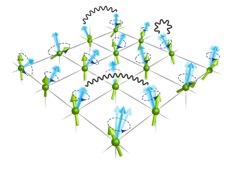Study

This course aims in introducing students to the theory of magnetic systems.
The course is separated in two parts. The first part is devoted to phenomenological models of magnetic systems, more specifically, to the Ising model and to different versions of the Heisenberg model. The ground states of these models are analyzed by employing thermodynamic approach and the mean field theory. A connection with Landau theory of phase transitions is established. Ferromagnetic and antifferomagnetic ground states as well as non-collinear ground states, such as skyrmion lattice and chiral magnets, are derived and investigated. Finally, the theory of spin waves is introduced for both anti- and ferro-magnets.
The second part of the course is devoted to microscopic foundations of magnetism that is formulated on the basis of Habbard and sd-like models. A special attention is paid to the role of spin orbit interaction of conduction electrons. Microscopic origin of Dzyaloshinskii-Moria interactions in magnetic systems is discussed in detail.
Part 1. Single particle QM methods
- Ising model in one and two dimensions
- Phase transition in the Ising model
- Landau theory of phase transitions
- Heisenberg model and its derivatives
- Magnetic ground states: ferromagnets, antiferromagnets, chiral magnets, skyrmion lattices
- Spin waves in ferromagnets and antiferromagnets
Part II. Introduction to many-body problems in QM
- Hubbard model for itinerant magnetism
- s-d-like models and their mean field analysis
- spin-orbit interaction
- microscopic foundation of Dzyaloshinskii-Moria interaction
- Ashcroft & Mermin, Chs. 31-33
- Kittel, Ch. 4
- D. Mattis, Theory of Magnetism I & II, Springer 1981
Grading policy:
20% of the final grade: presentation of problems during the seminar
80% of the final grade: written exam after the course

